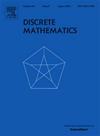More results on the spectral radius of graphs with no odd wheels
IF 0.7
3区 数学
Q2 MATHEMATICS
引用次数: 0
Abstract
For a graph G, the spectral radius of G is the largest eigenvalue of its adjacency matrix. An odd wheel with is a graph obtained from a cycle of order 2k by adding a new vertex connecting to all the vertices of the cycle. Let be the set of -free graphs of order n with the maximum spectral radius. Very recently, Cioabă, Desai and Tait [4] characterized the graphs in for sufficiently large n, where and . And they left the case as a problem. In this paper, we settle this problem. Moreover, we completely characterize the graphs in when is even and is sufficiently large. Consequently, the graphs in are characterized completely for any and sufficiently large n.
关于无奇轮图谱半径的更多结果
对于图G, G的谱半径λ1(G)是其邻接矩阵的最大特征值。k≥2的奇轮W2k+1是在一个2k阶的循环中添加一个连接到该循环所有顶点的新顶点而得到的图。设SPEX(n,W2k+1)为最大谱半径的n阶无W2k+1图的集合。最近,cioabei, Desai和Tait[4]在足够大的n下,在SPEX(n,W2k+1)中刻画了k≥2且k≠4,5的图。题目把k=4,5的情况留作一个问题。本文解决了这一问题。此外,当k≥4为偶数且n≡2(mod4)足够大时,我们完全刻画了SPEX(n,W2k+1)中的图。因此,当k≥2且n足够大时,SPEX(n,W2k+1)中的图是完全表征的。
本文章由计算机程序翻译,如有差异,请以英文原文为准。
求助全文
约1分钟内获得全文
求助全文
来源期刊

Discrete Mathematics
数学-数学
CiteScore
1.50
自引率
12.50%
发文量
424
审稿时长
6 months
期刊介绍:
Discrete Mathematics provides a common forum for significant research in many areas of discrete mathematics and combinatorics. Among the fields covered by Discrete Mathematics are graph and hypergraph theory, enumeration, coding theory, block designs, the combinatorics of partially ordered sets, extremal set theory, matroid theory, algebraic combinatorics, discrete geometry, matrices, and discrete probability theory.
Items in the journal include research articles (Contributions or Notes, depending on length) and survey/expository articles (Perspectives). Efforts are made to process the submission of Notes (short articles) quickly. The Perspectives section features expository articles accessible to a broad audience that cast new light or present unifying points of view on well-known or insufficiently-known topics.
 求助内容:
求助内容: 应助结果提醒方式:
应助结果提醒方式:


